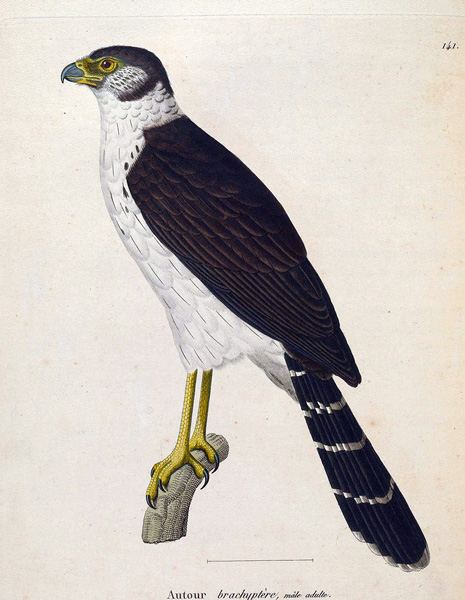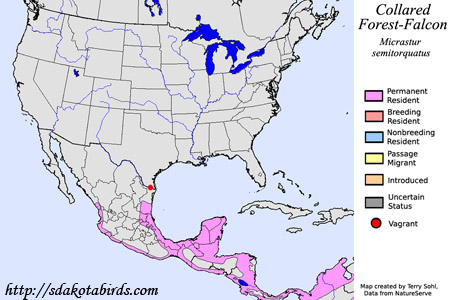Collared Forest-falcon
Micrastur semitorquatus
| Length: 18-23 inches | Wingspan: 28-34 inches | Seasonality: Non-resident in South Dakota |
| ID Keys: Dark grayish-black upperparts and cap, dark crescent extending down from crown and framing cheeks, white underparts, long legs and tail | ||
 The
Collared Forest-falcon is a large falcon of tropical forested areas in the
New World. Their range extends from Mexico southward through Central
America and into much of South America. Despite being one of the most common
forest raptors in parts of their range, they are secretive and can be
difficult to observe as they hunt and move through the forest canopy.
Females are considerably larger than males, on average weighing nearly 50%
more than their smaller mates. There are three commonly encountered color
morphs, dark, pale, and tawny, with the namesake light neck collar most
visible in the pale and tawny color morphs. Collared Forest-falcons were an
unknown species in the United States until 1994, when a bird was found in
Bentsen State Park in Texas along the Rio Grande river valley, on the border
with Mexico. The bird stayed for a few weeks in January and February, and
remains the only one of its kind seen in the U.S.
The
Collared Forest-falcon is a large falcon of tropical forested areas in the
New World. Their range extends from Mexico southward through Central
America and into much of South America. Despite being one of the most common
forest raptors in parts of their range, they are secretive and can be
difficult to observe as they hunt and move through the forest canopy.
Females are considerably larger than males, on average weighing nearly 50%
more than their smaller mates. There are three commonly encountered color
morphs, dark, pale, and tawny, with the namesake light neck collar most
visible in the pale and tawny color morphs. Collared Forest-falcons were an
unknown species in the United States until 1994, when a bird was found in
Bentsen State Park in Texas along the Rio Grande river valley, on the border
with Mexico. The bird stayed for a few weeks in January and February, and
remains the only one of its kind seen in the U.S.
Habitat: Found in a wide variety of forested habitats, including forest edges and clearings, secondary forest and shrubby regrowth, and mature forest. They are typically found in areas of dense undergrowth or a dense forest canopy, and typically avoid more open habitats, although they are more frequently found along forest edges than in the forest interior. They also tend to nest in cavities of very large, older trees, and unavailability of suitable nesting locations may be a limiting factor for the species in otherwise suitable habitat. In some locations where tree cavities are not available, they may occasionally use a cavity on a rocky cliff, or even a cavity in an abandoned building.
Diet: Feeds on a very wide variety of prey items, from the size of small frogs up to birds and other prey up to the size of an Ocellated Turkey weighing 6 pounds. Mammals often make up a majority of the diet, but they will also feed heavily on birds, and also sometimes on reptiles, amphibians, or large invertebrates.
Behavior: Uses a variety of hunting techniques, dependent upon location and area. A primary means of hunting is observing from a perch and swooping down to capture prey that it spots. They are also much more nimble on the ground than most raptors, and will often chase prey while on the ground. In South America they have been observed following moving colonies of ant swarms, capturing birds and other prey items disturbed by the swarm. Individual birds often specialize in a specific prey item, with birds in close proximity sometimes preferring different prey. Most hunting is done around dawn and dusk.
Nesting: The nest of a Collared Forest-falcon is a large cavity in a tree. The female typically lays 2 eggs (less often, 1 egg or 3 eggs), and she does all the incubation (typically around 45 days) while the male hunts and brings back food items. The male continues to be the sole food provider for 2 or 3 weeks after the young hatch. After that, the female may also occasionally leave the nest in search of prey. Fledging of the young occurs at about 50 days of age. This paper by Thorstrom et al. (2000) provides an excellent summary of Collared Forest-falcon breeding behavior.
Song: Given the dense habitats in which they live, vocalization is a key means of locating and interacting with others of their species. They have a haunting, three or four note call that is often heard in the early morning near dawn.
Migration: Collared Forest-falcons are considered non-migratory throughout their range.
Interactive eBird map: Click here to access an interactive eBird map of Collared Forest-falcon sightings
Similar Species: Generally distinctive if seen well.
Conservation Status: Populations of the Collared Forest-falcon are considered to be in decline. However, they are still found over a very broad geographic area and strong populations overall. The IUCN lists the Collared Forest-falcon as a species of "Least Concern". Habitat destruction is considered the biggest threat to the species.
Further Information: 1) BirdLife International - Collared Forest-falcon
2) The Peregrine Fund - Global Raptor Information Network - Collared Forest-falcon
3) Cornell's Neotropical Birds - Collared Forest-falcon
Photo Information: Public domain image from the Biodiversity Heritage Library
| Click below for a higher-resolution map |
 |
| South Dakota Status: Non-resident in South Dakota |
Additional Collared Forest-falcon Photos (coming soon!!)
